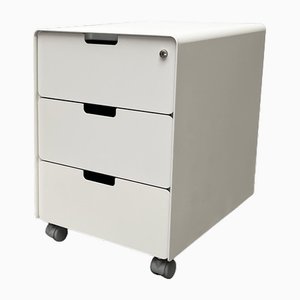
Swiss founders Willi and Erika Fehlbaum launched Vitra in 1934 as a shopfitting business in the Basel region, near the border of Germany and Switzerland. During a visit to America in 1953, the Fehlbaums became enamored with the innovative designs of Charles and Ray Eames—known today for the iconic Eames Lounge Chair & Ottoman (1956). In 1957, Vitra obtained licensing rights to produce Herman Miller furniture for the European market and began to manufacture the work of Charles and Ray Eames, as well as George Nelson—famous for the Pop Art-inspired Marshmallow Sofa (1956).
In 1967, after working closely with Danish designer Verner Panton, Vitra introduced the Panton Chair (originally conceived in 1959/60). The design was deemed a modernist landmark because it was the first wholly plastic, stackable, cantilever chair made in one piece. Vitra soon became internationally recognized as a company that collaborates with talented, progressive designers to create cutting-edge, high-quality products.
Rolf Fehlbaum (b. 1941), eldest son to Willi and Erika, became Vitra’s Chief Executive in 1977. In 1981, after a disastrous fire at the Vitra facilities in Weil am Rhein, Germany, Rolf commissioned British architect Nicholas Grimshaw to design a new manufacturing hall. More architectural commissions followed, and the Vitra Campus (as the architectural ensemble came to be known) earned acclaim for the way its high-concept, contemporary buildings integrated into the surrounding natural landscape and residential areas. Architect Frank Gehry designed the first public building, the Vitra Design Museum (1989), to house Rolf’s ever-growing collection of chairs, the largest collection in the world. Other buildings on campus were designed by the esteemed architects Tadao Ando (Conference Pavilion, 1993), Zaha Hadid (Fire Station, 1993), Alvaro Siza (Factory Building, 1994), and Herzog & de Meuron (VitraHaus, 2010).
After thirty years, Vitra’s partnership with Herman Miller was mutually terminated in 1984. Vitra, however, acquired the design rights to pieces by Charles and Ray Eames and George Nelson for Europe and the Middle East. For six decades, Vitra has been producing first-class furniture from iconic and internationally renowned designers and architects. Other famous designs in Vitra’s collection include Isamu Noguchi’s Noguchi Table (1939), Shiro Kuramata’s How High the Moon Chair (1986), Borek Sípek's Ota Otanek Chair (1988), Philippe Starck's Louis XX Stacking Chair (1992), and numerous patterns and textiles created by Alexander Girard. Vitra has also won countless design-related awards, such as the Lucky Strike Design Award in 1994, and their pieces can be found in design museums around the world, including the Tate Modern and Design Museum in London, Museum of Modern Art in New York, and, of course, Vitra Design Museum in Weil am Rhein.
* Images courtesy of Vitra

